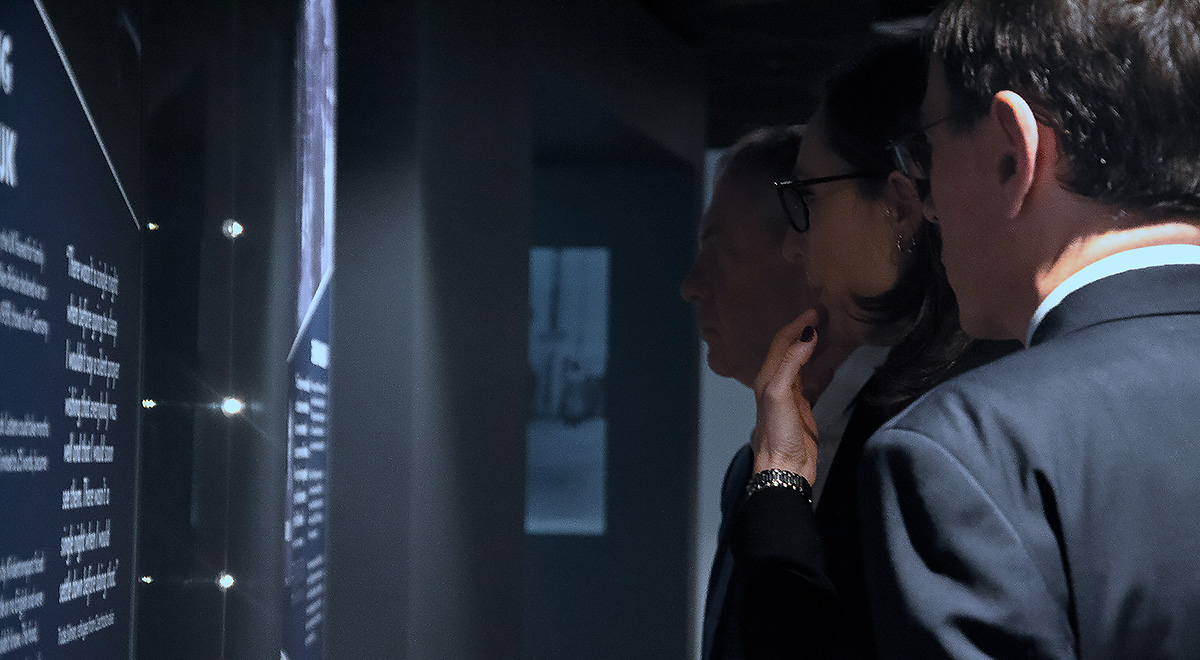The former Labour MP is an independent advisor to the government on antisemitism and recently visited the Centre which is based at the University of Huddersfield
 Lord Mann was given a guided tour around the exhibition by Emma King, Director of the Holocaust Exhibition and Learning Centre who was accompanied by the University’s Deputy Vice-Chancellor Professor Tim Thornton.
Lord Mann was given a guided tour around the exhibition by Emma King, Director of the Holocaust Exhibition and Learning Centre who was accompanied by the University’s Deputy Vice-Chancellor Professor Tim Thornton.ONE of the country’s leading figures in speaking out against antisemitism paid a fact-finding visit to the North of England’s Holocaust Exhibition and Learning Centre based at the University of Huddersfield.
Former Labour MP, Lord John Mann, was given a guided tour around the interactive exhibition ‘Through Our Eyes’ by the Centre’s Director Emma King and the University’s Deputy Vice-Chancellor Professor Tim Thornton.
The Centre was opened in partnership with the Leeds-based Holocaust Survivors’ Friendship Association who had personally invited Lord Mann to come and see the Centre along with the University’s Vice-Chancellor Professor Bob Cryan.
Until recently, Lord Mann chaired a cross-party parliamentary group on antisemitism and in July he was appointed by the Government as the new Independent Adviser on Antisemitism and is leading an inquiry into tackling hostility and discrimination against Jews.
The exhibition documents the individual stories of a group of young people who survived Nazi persecution along with personal testimonies from survivors of the Holocaust, who went on to make new lives in the North of England.
The tour began with a look at propaganda and its influence on ordinary people before and during World War Two and how quickly prejudice can turn to persecution and to genocide.
Lord Mann, nodded in agreement as Emma explained how the photos, videos and music on display sent a powerful message about the perils of antisemitism and all forms of racial prejudice, as they tell and illustrate the story of Nazi persecution of Jewish people and the systematic attempt to annihilate them.
This led onto a discussion on there being a danger of misconception among today’s youth that the kind of atrocities portrayed against Jews, only ever went on in the 1940s and once liberated, everything was fine.
Professor Thornton pointed out as this certainly wasn’t the case, it was even more important to share the stories of the people who did survive, including the highs and the lows of making new lives, after their liberation in 1945.
Emma told Baron Mann the Centre had been involved with a project entitled Making a New Life. This had included some interesting and quite challenging interviews with people speaking about coming to the UK and the difficulties and struggles they experienced when creating businesses or finding a job.
In the video, Lord John Mann says it is vital for everyone today and for the community of Huddersfield, that we learn the lessons of history and that all local people should want to come and learn from what is on display at the Centre.
- Watch more of the University's video content on the University's YouTube News Channel.
As they looked at the exhibits, including one on the Kindertransport which explained how 10,000 Jewish children were given refuge in the UK, after paying £50 for the visa, Emma talked about how a chilling realisation for many young people viewing the exhibition was when they found out that people just stood by and let the Nazi regime take over.
“The machinery of the Holocaust took place in plain sight and with active participation of collaborators across the whole of occupied Europe,” said Emma.
The Baron heard how the Centre teaches youngsters to critically examine how German Nazis succeeded in destroying Jewish communities across occupied Europe with the help of collaborators, ordinary men and women, living often as neighbours.
He viewed original artefacts from the survivors’ personal documents and possessions, including a yellow star that Jews were obliged to wear across Germany and Nazi occupied Europe that belonged to the family of Heinz Skyte.
Heinz’s story of how he survived the Holocaust is one of the stories featured in the exhibition alongside an original concentration camp prisoner uniform on loan from the memorial site at the former concentration camp Mittelbau-Dora in Germany. which was also on display.
The Director of Mittelbau-Dora’s Concentration Camp Memorial, Dr Stefan Hördler recently visited the HELC when he was invited to deliver a guest lecture on perpetrator photography, specifically those displayed in the ‘Auschwitz Album’.
The album contains the only photographic evidence of transports into Auschwitz-Birkenau, of the Hungarian transports on which Eugene Black, father of Lilian Black, Chair of the HSFA, and his family were deported.
Baron Mann pointed out the importance for more work to be carried out on perpetrators, specifically those who were non-German, because it is important to show people that it wasn’t just those who were German who committed atrocities.
The tour ended with an immersive animation in the Centre’s visual suite, broadcast on multiple screens. Baron Mann heard how by bringing personal testimonies of Holocaust survivors to life, the Centre engages with the younger generation so they too can learn about the Holocaust and be alert to racism.
“It is vital for us today and for the community in this area tomorrow that we learn the lessons of history,” said Baron Mann. “To bring it alive through the experience of people who have lived in this area for many decades, I think has a real resonance to it, that all local people should want to understand.”
- The Centre was created after being funded by National Lottery for Heritage Funds, Pears Foundation, the AJR, Wolfson Family Trust, Toni Schiff Memorial Fund and by kind individuals and families who support the Centre’s vision for a better world free of fear and discrimination.
